#books 1 and 2 are both over 400 pages
Note
i wasn't sure if you would read the tags i'd leave if i reblogged your reply to my ask so i decided to just send you another ask! ha! i'll bullet point them this time bc i have quite a few things to say:
1. you can definitely keep my asks public, i really don't mind :)
2. never have i ever been so excited to open an email, and that too first thing in the morning. seeing your reply, especially that little treat at the end (!!!!!!!!!), had me smiling and kicking my feet in bed. i'm, impossibly enough, even more excited for Emberclaw now.
3. having more than one narrative position in a book is certainly ambitious and one that i haven't encountered in any other book so far, but it grows on you, fast (at least it did on me), and can be an acquired taste to some who are willing to give it a chance. i think you might just be the first author who has changed my mind completely on first person narratives and i owe it to your flawless delivery, of course (i'm biased, i'll admit). also, "narrative positions" was exactly the word that wouldn't come to me in my fit of excitement while writing my last ask; it was a tiny brain-fart moment on my part when i said "pov choice" instead haha.
4. this is more of an aside really but it once took me 400 pages (of a 800+ pages) to get into a book, so imho, 50 pages isn't asking for much. fantasy novels tend to be a little demanding! also, it was my first proper foray into epic fantasy. i then went on to finish the series despite the really, really, really slow start. the slowest. i think a reader can tell when the wait will be worth it though, almost like a gut feeling.
5. multi-pov is another polarizing aspect of books, but then again, it can be enjoyed if done well. i once read a book with 14 povs and gave it 5 stars. it wasn't even a fantasy novel, but a contemporary one! in comparison, your book with its 4 povs is pretty tame, and i think, even the norm for epic/high fantasy novels. personally, i enjoy being in the head of different characters! especially when you've got a big cast of them. also, that surprise 5th pov toward the end took me quite by surprise!! jaw, meet floor.
6. i do have a GR account! and i certainly have plans on leaving well-deserved, glowing reviews on both the book and audio :) it's the least i can do!
7. this one is more of a suggestion to those who might find the narrative positioning a little jarring: listen to the audiobook instead; it warms you up to it much faster!
i think that just about covers it. again, i cannot say this enough, but Dragonfall would not be the story i fell absolutely in love with had you not made the narrative (ha!) choices you did. i hope more people come to appreciate and love it as much as i do, and are willing to give it the fair chance it deserves <3
much love 💖
I think I'd see the tags! I'm so out of practice with Tumblr, but I have enjoyed coming back to it as I feel in some ways I can be more authentic over here rather than the more traditional promo over on tiktok and insta. Not that I'm inauthentic elsewhere it's just...here you can be a bit more off the cuff, I think?
1. Whew!
2. Aww yay! Interacting with readers is honestly one of my favourite things. I'm so excited when I hear from someone who got what I was trying to do. Releasing art for public consumption can be excellent but also hard. Dragonfall is probably my most personal book, so it being marmite made me so self-conscious. I always think about that Don Marquis quote "Publishing a volume of verse is like dropping a rose petal down the Grand Canyon and waiting for the echo." It's nice when you get the echoes back. :-)
3. I was inspired to be experimental after reading The Fifth Season, which is a masterpiece. I've heard good things about The Spear Cuts Through Water which also does cool narrative position trickery, I think. I also really love framing devices of people looking back, like in Assassin's Apprentice by Hobb (my fave author, as evidenced by the dedication). I'm glad I could open you up to all the opportunities of first person! I taught a class on narrative positions when I was a creative writing lecturer so I'm just very passionate about how form can marry function, hah.
4. Yes, four (technically five) is tame compared to some! I did seven in Seven Mercies and whew, that was a lot, even though technically my co-writer and I mostly split it up. My next projects will be 2 and then 1 as a bit of a breather. It is harder to balance multi POV, but I love the "heteroglossia" potential of storytelling.
6. Thank you!
7. I wish I could listen to the audiobooks of my books! I get too self-conscious or want to edit. I can say that Philip and Rachel did amazing jobs from the samples I head, though, and I was super excited they hired a nonbinary voice actor for Arcady. This was also my first time having more than one voice actor, which was neat.
And yes, I hope so too. <3
4 notes
·
View notes
Text
A lot of people are confused with timeline of Throne of glass. Indeed there are 8 books with each over 400 pages so that's not unexpected. So I put books and events chronologically to explain the whole series
Assassin's blade - timeline starts around one and a half year before Throne of Glass. In the first novella The assassin and the pirate lord timeline takes around 3 weeks ( Celaena and Sam go to Skulls Bay to see Captain Rolfe). Their journey to the islands takes around 1 week and they stayed there for a week untill they demolished the whole place. In the two other novellas The assassin and the healer and The assassin and the dessert timeline stretches for 2 months. Celaena stays in Innish for 2 days and meets Yrene and teaches her self defense. After that she goes to Red dessert to meet Silent Assassins. She stays there 1 month and it takes her 1 month to come back to Rifthold. In last two novellas The assassin and the underworld and The assassin and the empire timeline takes place around 1 month when she understood her feelings towards Sam and wanted to move away with him. That was in June because she heard ladies in taverns gossiping that Crown Prince is going to the beach with his friends for his birthday. It's important to notice that in between novellas are time gaps due to her travelling and so on.
Then it's a year break in between two books due Celaena going to Endovier
Throne of glass - the timeline takes place around September when Dorian and Chaol went to Endovier to get her be Dorian's champion in competition. It takes them 2 weeks to come back to Rifthold and then her training starts that last around 2 weeks. She recovers and the competition starts. It's said that the last competition will be held after Yullemas and that's 21st of December . So the book ends at the end of December
Again the break between two books around one to one and a half month due Celaena going to her missions.
Crown of midnight - book starts at the beginning of February. She and Chaol become even closer and soon it's his birthday. It's around middle of February ( 14th of February;) ) and they confess their love towards each other. It's said that they were together for a week until Nehemiah's death happens. Chaol then send her to Wendlyn
She goes off to Wendlyn and it takes her 2 weeks to get there.
Heir of Fire - in first two weeks Celaena lays on roofs of Wendlyn until Rowan spots her and brings her to one of the keeps for in a case of siege. Plot continues as Celaena trains with Rowan. In that time the love story between Dorian and Sorscha happens that lasts couple of weeks. And the book end around middle of May because Celaena's birthday is at the begging of May and she was still training at that time. Week later she came to Doranelle as she mastered her gifts and confronted Maeve.
Another pause of two to three weeks after she onboarded to the ship to Rifthold and after Sorscha's execution.
Queen of shadows - the whole plot is told in two weeks, nothing more, nothing less. The reason is that when Celaena came to Rifthold she met Chaol again and made a plan how to rescue Aedion. That took 2 days. The dinner with Arnobynn and his murder happened during that week. After that they planed how to free Dorian from the Valg collar. Their trip to Oakwald forest took 4 days and after they came to Rifthold, the day after, Celaena presented herself as king's Champion who came back from Wendlyn. The glass castle scene happened and that sums up this book. So the book takes place in June because Dorian's birthday is mentioned and in Assassin's blade it says it's in begining of summer.
After that Aelin and her court parts with Dorian and Chaol to go to Terrasen which journey takes two to three weeks.
Empire of storms / Tower of Dawn - those two books take place in the same time but the perspective and place are different. In empire of storms it's in Erilea while in Tower of Dawn it's in Antica due to Chaol being invalid. Both books take place during the summer but while Empire of storms end in August due to Aelin being locked in coffin, Tower of Dawn continues until September. Because it mentions Yrene's birthday while the weather becomes colder.
Another pause of two months and during that time Aelin is held captivated in Doranelle.
Kingdom of Ash - the two months have passed and Rowan, Elide and Lorcan continued for their hunt for Aelin. Until she blows off some of the power they sensed her and planed to distract Maeve until they rescue her. It took them two days for the whole rescue plan and another five days to get to the Wendlyn's shore flowing in underground waters. During that time Chaol and Yrene travel from Antica with the army until they hear that there is attack on Anielle. The siege lasted five days until Aelin and her court appeared to beat the army. During that time Dorian and Manon find Croochan's while Aedion and Lysandra fight in Terrasen. Time laps between every battle in the north is around one to two weeks because the only mentioned are in Eldrys and in Perranth ( not including one In Orynth ). After that they march towards north when the final battle of Orynth happens. In one of the dialogues Rowan tells Gavriel they will fight in Terrasen with Aedion before Yullemas. So the story ends in late November. In the epilogue it's fast-forward to spring and rebuilding the kingdom.
Disclaimer : this is not synopsis of the series and I did not include a lot of events, only the one that are important to understand time-place connection.
I hope it helps!
#throne of glass#aelin galythinius#rowan whitethorn#dorian havilliard#chaol westfall#yrene towers#throneofglasstimeline#elide lochan#manon blackbeak#lorcan salvaterre#gavriel#fenrys moonbeam#sarah j maas
62 notes
·
View notes
Text
The End and the Death: Part 3
The story begins 6 years ago when I was bothering my little brother one night. I had spent the night at my parents’ house over the summer (he was home from college) and he was just trying to get some play time in Warframe. In an effort to get rid of me, and he told me to read Horus Rising, and to only come back if I got bored.
I did not. In fact, that night I read the entirety of the first book and spent the next morning begging for the next. I’ve written extensively over the years about my experience with Warhammer (if you click the tag “Djem reads Warhammer” you can track my rollercoaster over the years) but the thing that I have been waiting for since I first started was the end. The End - and the Death.
You see, I am a unicorn. I have, despite my years both on the internet and in nerd fandom, not actually ever encountered details of 40k. Part of this is because Games Workshop, and Black Library by extension, are both utterly terrible at marketing. They seem to approach Warhammer with a “if you know, you know, if you don’t, may God be with you” approach that means that unless you actively go hunting for information (and if you are careful to avoid fandom circles and not read the afterwords of novels) it’s actually remarkably easy to spend the last 6 or so years having absolutely no clue what the hell happened at the Siege of Terra—or after it. (For context, I have both played the Space Marine game and owned the Roboute Returned model for basically the past 6 years and I neither knew Roboute was dead or that he had come back, because neither mentions either. Yeah, I know.)
Before 3 days ago, I knew the following information only:
1. The Imperium survived
2. The Emperor, if not alive, was at least known and venerated as a god
3. Space Marines were still a thing, albeit organized differently
4. The Primarchs, at least the loyal ones, were known in the future (if not still physically present)
5. Xenos and man still fought
6. Chaos still had a grip on the galaxy
7. Horus lost
And that was about it. I didn’t know what happened to the primarchs after Horus was defeated (who survived, who died etc). I didn’t know what happened to the Emperor. I didn’t know how the Imperium came to be reorganized (although I did possess enough ability to discern, via context clues, that Roboute was at least responsible for the Codex and probably the reorganization of Legions into Chapters). I didn’t know what happened to many of the characters I had come to love and hate after the war was over. I knew virtually nothing. I didn’t even know if certain dead characters were actually dead.
As of 3:00 pm on Saturday, following the completion of EaTD3, I knew the following:
1. The Imperium survived
2. The Emperor “lived” to be venerated as a god
3. Space Marines were still a thing, albeit organized differently
4. The Primarchs, at least the loyal ones, were known in the future (if not still physically present)
5. Xenos and man still fought
6. Chaos still had a grip on the galaxy
7. Horus lost
If you are noticing a particular sameness to the lists, it’s because End and the Death volume 3 told us nothing. In fact, it told us less than nothing, because at least nothing would be something. But EaTD3 was 400 pages of walking and a fight, and it ended so abruptly I didn’t even have time to realize it was over.
I realize, to many, that because, other than lore implications, EaTD3 had to only serve to answer canon questions which have been evolving for the past 30 years, the novel simply ending when Horus died is hardly an issue. Most people know what happens next, they’ve been immersed in the lore, they may have even already read what happens to most of the characters. I realize that I am a unicorn. But regardless of knowing or not knowing, this book was a book. It wasn’t a lore guide or a codex. It was a novel, and it was a novel that was the capstone of, if not the entire Heresy, then at the very least the Siege. The fact that it was written by the man who started the series, the man who made me fall in love with Warhammer, meant that, perhaps, I expected something more. I expected a novel, an ending to the characters and stories that I had loved for the past 6 years, not an abrupt closing to a story that remains unfinished. This is the end of the Heresy, and while for most characters the story doesn’t end here, we needed closure. Catharsis. We needed a denouement.
The fundamental approach I think was flawed. The story should have been written as though no one knew what was happening, as the ending of a story, not a list of lore points that wrap up one era to introduce a new one. We needed to look at characters that mattered, if not in the Heresy as a whole, at least in the Siege, and we needed to end their stories. We needed to look at characters who have been important since the beginning, and make sure that their stories continued to matter until the end.
EaTD3 gave us none of that. Oh, it was beautifully written of course. Dan Abnett is nothing if not a wordsmith, and as usual his books are a pleasure to read. His grasp of language and his ability to turn a phrase or coin a term are second to none, but this book, for perhaps the first time, left me wanting more.
EaTD2 was an emotional rollercoaster. I think I cried at least every two chapters—even recounting certain moments later had me tearing up with the grief and loss and sacrifice and heroism. But it ended as abruptly as this one dead—Sanguinius dead on the floor.
I think that is what got me most about this book—the lack of feeling. For a man who can make me tear up over the emergence of a tank from the mists on Calth, I was expecting a deep wellspring of emotion regarding, well, almost everything, but instead, I was left feeling hollow. Dorn retrieves the skull of Ferrus Manus, and we don’t even see it. He just pops it into a grocery bag and hands it off to a random Blood Angel and that’s it. The Emperor’s near death is mostly ignored, with the focus less on the man himself and more on figuring out how to rig up a makeshift pallet. Sanguinius’ body is an afterthought left to his sons, and Garviel Loken is killed in a GOT style death that makes you wonder if Abnett had simply run out of steam. This novel was, in short, a couple of fun easter eggs on a series of lore points long known and oft debated, and was, in the end, nothing more.
What follows is a list of my particular issues, not in any particular order: (hyperlinked bc tumblr gets mad at me when I write too much)
Sanguinius
Right Scene, Wrong Person
Waste of Time or Too New?
Needed More (+ weird things)
Garviel Loken
#warhammer 30k#the horus heresy#warhammer 40k#horus lupercal#sanguinius#djem reads warhammer#i am at LONG LAST#free to follow all the warhammer blogs#bc nothing is a secret anymore!#so yay me
4 notes
·
View notes
Note
Hey!!! I’m curious to know, why don’t you like Bryce or CC? Personally the first book was better than the second book but overall, the series hasn’t been too bad (minus the whole crossover thing)
You want to ask me, on this our first day of elucienweek, why I hate Bryce and CC? ESPECIALLY when you admit you like them? Oof.
I mean, I'll share but I'm not interested in changing my opinion or like, softening this.
First of all, and I will die on this hill, Bryce is a fucking pick-me of the HIGHEST order. This is a problem with the narrative and not so much her, but if I wanted to read endless prose on how fucking hourglass, Kardashian hot a woman was, I could pick up a Branden Sanderson novel. EVERY SINGLE MAN has to simp for Bryce, including Ruhn who has a very uncomfortable passage in the first book where he is looking her up and down in her tight jeans. Bryce can't walk down the road without being sexually harassed and she seemingly likes it. Who's fantasy is that? What in the wattpad is that?
Second, every single man in the book is standing in a line behind Hunt to fuck Bryce. IDK what your experience with this is, but I have some personal experience with men pretending to be your friend so they can have a shot. It never reads as genuine but OF COURSE Bryce doesn't mind that they all openly and desperately want to fuck her. We're treated to thought after thought about her body, looking her up and down in a way that feels very "through the male gaze" and I was just over it 400 pages in. WE GET IT. Oh my GOD.
SJM loves to do this thing where she puts you in the POV of a character who has knowledge the reader should know and instead will use that POV to lie in order to create some big reveal. 500 pages looking for a missing child? LOL Bryce figured that out on page 26 and this whole side quest has been a massive, frustrating waste of time. Of course she did, she's so smart. She suffers from Aelin syndrome where she just keeps secrets from EVERYONE because, presumably, no one can be trusted? For ReAsOnS that made me want to slam the book to the ground.
Of course Bryce is also the main protag so we're told over and over she's smart and talented and whatever but OH MY GOD everything she does is STUPID AS SHIT. This was my issue with TOG. Aelin was the best assassin, according to the narrative but every time you saw her assassin-ing, she was pretty bad at it. Or how Cassian/Azriel are elite warriors but endlessly injured. Like, either make your characters NORMAL or make them REALLY badass. Bryce isn't particularly smart, she's impulsive and makes endless bad decisions and it's just fine.
The whole "we're better than the humans thing" was a choice. That whole plot, in book 2, where Bryce is just 'meh' and treats the rebellion like they're beneath her was a really bad look. Was it supposed to convey she's better than them? Because honestly, both books give off this supreme sense that Bryce thinks she is just better than everyone else and she does not need to treat the people around her well. She's shitty to Lebehah (or whatever her name was) and that creature literally DIED for, why? She's shitty to Ruhn who is endlessly going to bat for her, she was unnecessarily bratty with Hunt in book 1 when he was trying so hard to help her with Danika, like this is a pattern of behavior for Bryce.
And unlike Feyre and Aelin who like, grow and learn, Bryce gives off this aura of "I am fine as I am" girl you are easily the worst of the three. Like I get it, party girl roped into shenanigans but we are 1600+ pages into this story and Bryce is just stagnant and not particularly fun when you're trapped in her headspace. I read book 2 because twitter spoiled the ending and I knew I was going to have to read it in order to continue ACOTAR, but honestly if SJM wasn't doing this cursed crossover, I would have DNF'd.
And if you liked it, I'm not saying you're wrong for it or whatever. I know a lot of people prefer CC to ACOTAR and TOG. I think it suffers from all the same problems as SJMs other series but her protag isn't half as likable. Her side characters are. My love of Ruhn is decently known. Ultimately there are too many problems with the convoluted narrative that don't make it enjoyable for me.
54 notes
·
View notes
Text
Back when I had just moved out and started doing my own thing my father reached out to me asking that I help out a friend of his complete a children's book she was working on, I agreed and started texting back and forth with the writer and was fairly excited since it was a cute story and she seemed nice enough ... Until I asked about payment. 🤨 red flag #1
She didn't want to discuss money until she "knew what she was paying for", ok understandable, I could've sent her examples of already finished art work but she requested that I make full color "test pages" of a part of the story that she'd sent me to look over and full designs for the characters, with no payment guaranteed !! 🤨🤨🤨 red flag #2
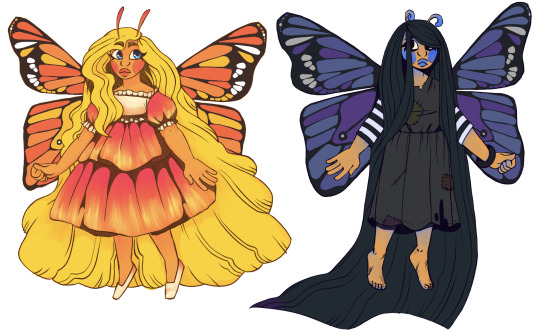
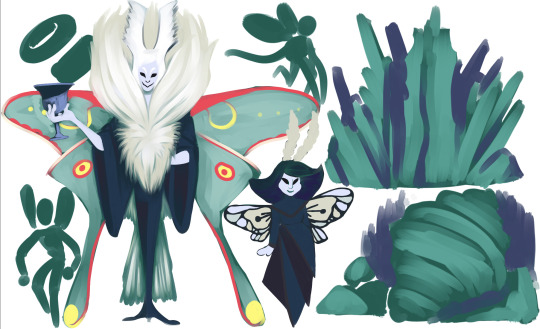
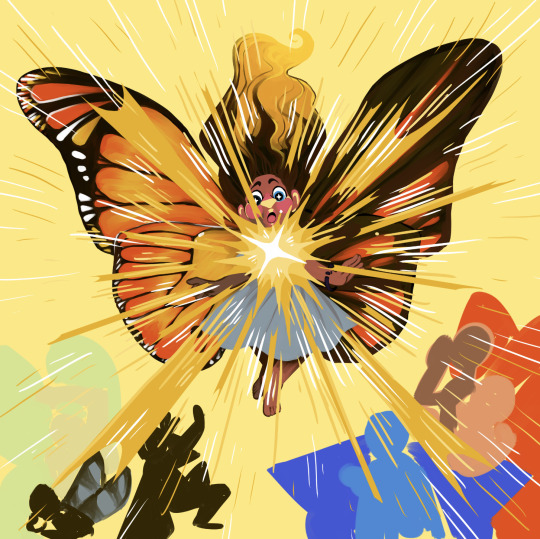
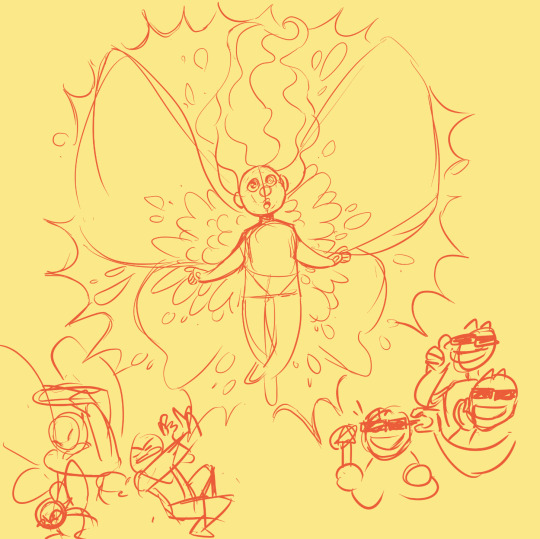
Now at this point we'd been going back and forth for a couple days over this issue while I worked on the pieces you see above, I had convinced her to be content with getting one test page and the character designs while also putting my foot down on what I expected to be paid for , which of course would be any and all art she wanted me to make. I went over what the "industry standard" was , and that I'd expect something comparable.
In the end she decided that she didn't want to pay me for cover art, wouldn't agree to royalties since she was "a first time author" (which wasn't true she had released several books this was just her first children's book), and only wanted to pay like $20 a page (sooo $400 for a 20 page book 😬) red flag #3
I only agreed to this setup as I was tired of arguing with a brick wall and at least had some numbers to work with. Unfortunately for her I was young , petty and very unprofessional and as soon as she started pushing for me to "hurry up so they can release the book" I just ghosted her. Texts and emails went unanswered and eventually she quit contacting me. I assumed she had found someone else to bother for art and forgot about the situation for years until I stumbled upon the art in the archives.
I got curious , looked up the author to see if the story had actually been released and it was! The art was very cute and well done (Also a very different art style then what she originally told me and had sent references of so I'm glad I didn't do much more since she might have been unhappy with the art anyway 😭) Despite the bad taste left in my mouth after our original interactions, I'm glad she found someone and only hope she was less of a pushy jerk with them 🙄
All in all I did learn alot from this, Mainly that I don't start any kind of work until payment is agreed upon by both parties and if someone gives me the ick I don't have to deal with them, and to be wary of people my dad recommends to collab with (which I should've known better at this point but ya know hindsight 20/20 lol)
I'm still quite happy with the work I did do so I'm sharing it here UwU
#art#drawing#illustration#digital art#digital aritst#children's books#book art#long post#kat chat#text post#...mostly
4 notes
·
View notes
Text
Fate Japanese Art Book Haul

So, a big old order of Fate material. But still, even with this much being added to my collection I've scratched the surface of Fate/Type-Moon material. This (alongside my other Heaven's Feel stuff) represents the majority of anime art book works, but still I'd say I'm only getting to about 50, maybe 60, percent of the anime art books currently. So yeah, still loads to go on all fronts, but good progress! Anyways, let me dive into the art books from top to bottom in the above image.
Fate/Prototype Animation Material

This one is really interesting to me. The vast majority of the art book is just the storyboards for a single 10 minute OVA. The amount of projected and potential work in this art book comfortably outweighs the information we get in the OVA, making it a super cool look into the original concepts that Nasu had for the Stay Night route.

Of course, the book has more than just storyboards to it, as it starts off with character and prop design pages in full color. Super cool to see so I sort of wish they included more extraneous production aspects alongside it, but I won't really complain given how much material there already is, and the fact that I got it for dirt cheap (a little over 5CAD at auction).
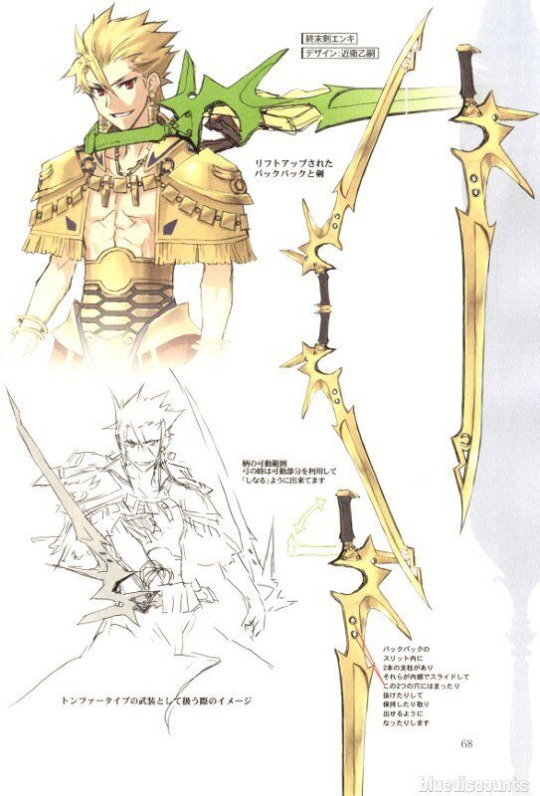
Fate/Zero Openings and Endings Key Animations
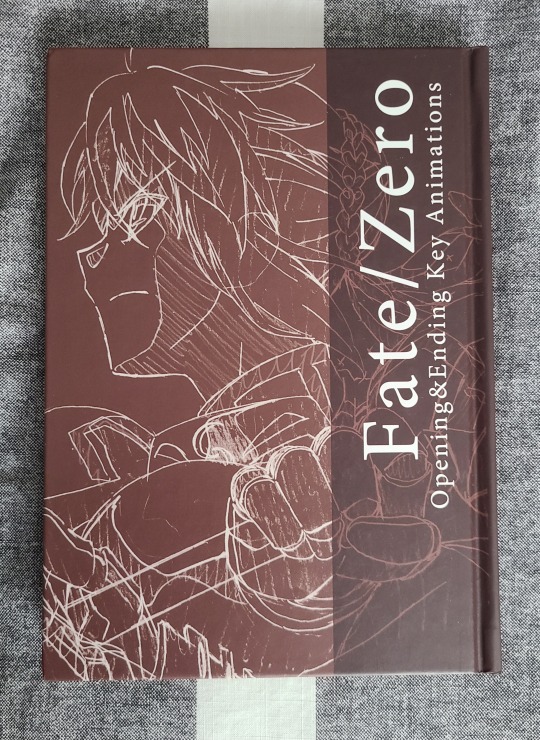
Another sorta extra purchase, but for how much it was (10.50CAD and it's Hardcover), I wasn't going to pass it up in the moment. Have to fill out that roster somehow, right? Anyways, it's a relatively small art book, just a bit bigger in trim than the Prototype one, but it's really cool to have the openings and endings in keyframe format. Lots of pretty stuff in there.
There is a proper item set for this though. It originally comes in a box with a pair of extra material books including storyboards for the openings and endings. The whole set itself is a bit of a challenge to find at times, but the individual items are very abundant, so I'll probably be picking them up in the next haul or two if I can find them for cheap. Or maybe I'll double dip and get the box if I can, it does seem pretty cool (also comes with bonus full sheets from the OPs/EDs).
Image from this art book blog, which you should definitely check out

Fate/Stay Night Unlimited Blade Works First Season Key Animations

This was really cool. I'm a big cheapskate (despite how much I buy), so I was incredibly happy to have won the auction for this pair of books at only around 20CAD each. What's not cool, but rather confusing, is how different the second season key animations set is. It's a colored and metallic dust jacket. Very weird, right? Anyways, it's super cool fate stuff and the key animation is as incredible as you might expect.
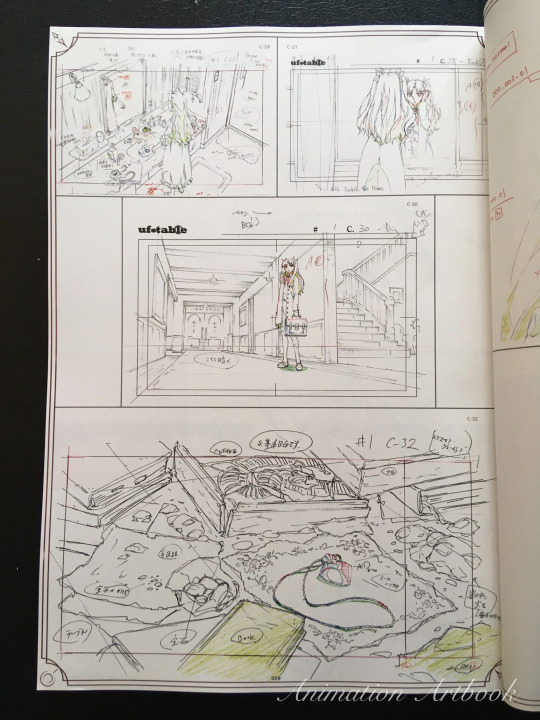

Fate/Stay Night Heaven's Feel AD Correction Collection Volumes 1 & 2

I feel like a fraud, only having things for Heaven's Feel 1&2, but Spring Song stuff is so expensive. I could get the first two storyboard collections for both Heaven's Feel and Unlimited Blade Works for less than I can typically find the Spring Songs Key Animations for. It's so rough. Anyways, these are a collection of the correction done by the Art Director for Heaven's Feel. You could say it already overlaps with the Keyframe Collections of their namesakes, but I think it's interesting to see the changes and overall process of the work.
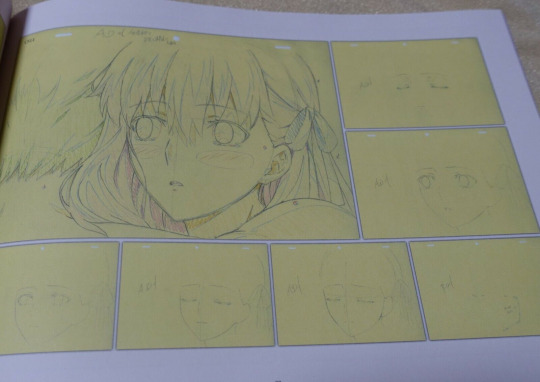

Fate/Zero Key Animations Collection
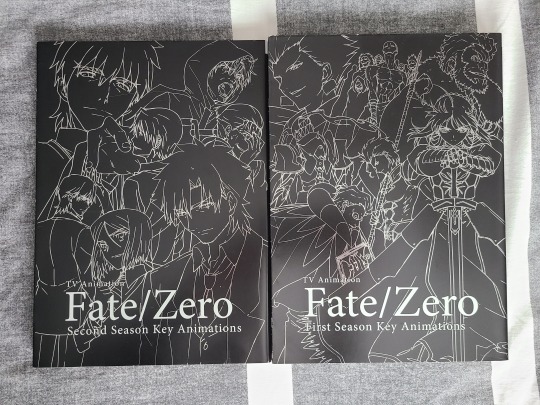
I really appreciate that Zero kept the dust jackets consistent for itself. UBW Season 2 really is just the odd one out of Ufotable's Fate collection. Regardless, it's pretty much the same story as the UBW keyframe collections, plenty of cool and very pretty keyframe art that provides a window into the production and work of Ufotable on the series.


Fate/Grand Order Trailer's Trail Volume 1

Now hear me out, I don't play FGO, but I do enjoy the quality of the trailers, and when an A4 book comprised of over 400 pages of key animation is 10CAD it's hard to look the other way. In general though, it's pretty cool, and well organized into chapters so you don't get pieces mixed up with each other. Definitely worth it for any fans of the game, or just like some really well animated Fate stuff.


Ufotable 15th Anniversary Exhibition Pictorial Record

This was a pretty cool pickup. Special art stuff for studios as a whole isn't something that greatly interests me, but Ufotable is definitely a studio I'd be interested in having a history of, even if I'm not a fan of everything they work on. Overall it's a very pretty and well constructed hardcover art book, with a nice helping of works from all across their years (which they did an excellent job of selecting the best moments from).

And that about does it with this haul. As you can tell, there's a lot here, but also a great deal that I'm still missing. The more you come to understand and have, the deeper the abyss seems to grow. At the end of the day though, it's incredible fun and something I've grown to be incredibly passionate about. There's so much history to all of these art books, so many memories and so much passion behind it all. Having a record of all of my favorite series and titles and animators just feels right. I'm able to be in control of what I remember of them and it's a really great feeling.
#fate artbook#kinoko nasu#type moon#fate/stay night#fate/zero#heaven's feel#unlimited blade works#ufotable#fate/grand order#fate series#fate#anime art book#art book#animation
6 notes
·
View notes
Text
End of the year book asks! Which I'm just... going to fill out. Original post here.
1. How many books did you read this year?
As of posting this on December 15th, it's 36, with a note that I am including zines over 100 pages. Will update at the end of the year! Edit: 38!
2. Did you reread anything? What?
Reread Gideon and Harrow the Ninth in preparation for Nona's release!
3. What were your top five books of the year?
Okay. I am going to categorise.
Favourite novel: Tamsyn Muir - Nona the Ninth
Favourite novella: Becky Chambers - A Prayer for the Crown-Shy
Favourite series: Seanan McGuire - Wayward Children
Favourite anthology: Xenocultivars - Stories of Queer Growth
Favourite zine: Archive of the Odd (available here, only read issue 1 so far but I have issue 2 purchased and ready to go!)
Favourite unexpected addition to my reading list: Bram Stoker - Dracula
Other favourites of note: Travis Baldree - Legends & Lattes, RoAnna Sylver - Stake Sauce 2 and Life Within Parole vol 2, Freydis Moon - Exodus 20:3
4. Did you discover any new authors that you love this year?
Read the Wayward Children series, would be quite happy to look into more of Seanan McGuire's writing!
5. What genre did you read the most of?
I am sitting comfortably in my SFF hole, thank you.
6. Was there anything you meant to read, but never got to?
*laughs in excessively long TBR*
7. What was your average Goodreads Storygraph rating? Does it seem accurate?
4.32, which seems pretty solid!
8. Did you meet any of your reading goals? Which ones?
I did, averaging three new reads a month!
9. Did you get into any new genres?
Is 'gothic horror that is actually all about The Power Of Friendship' a genre?
10. What was your favorite new release of the year?
Nona the Ninth Nona the Ninth I cannot reiterate how much I goddamn adore Nona the Ninth. Sob.
11. What was your favorite book that has been out for a while, but you just now read?
Dracula has been out for. A while lmao
12. Any books that disappointed you?
13. What were your least favorite books of the year?
Mm. I don't like naming names because I can totally see people enjoying it, but there was one novel in particular that I felt didn't quite stick the landing. I gave it a 6/10 rating.
14. What books do you want to finish before the year is over?
I'd like to get in Where The Drowned Girls Go (the last Wayward Children book currently out, the next one is due in January!), which will be easy enough because it's a novella, and probably one other. Edit, 16th December: Done!
15. Did you read any books that were nominated for or won awards this year? What did you think of them?
I got into the Wayward Children series, most of those either won or were nominated for the Best Novella nebulas, and which won this year's Best Series. This Is How You Lose The Time War won that category for the Hugos, Nebulas, and Locus in 2020; Binti: Home and Night Masquerade were also nominated for Hugos.
Also I feel Dracula's probably won a few awards. Probably.
16. What is the most over-hyped book you read this year?
Oh, hm! I don't know, most felt like a suitable level of hype.
17. Did any books surprise you with how good they were?
Dracula. Dracula. I expected to read it as like, a pivotal vampire/horror novel that I felt lowkey obligated to get through but I fucking loved it. At least part of that was the Dracula Daily experience but damn, I really liked that book.
18. How many books did you buy?
.......significantly more than I actually read. Awkward laughter at my Kobo account.
19. Did you use your library?
I did!
20. What was your most anticipated release? Did it meet your expectations?
Nona the Ninth, and it absolutely did. I knew I would be goddamn deceased after it and I very much!! was!!
21. Did you participate in or watch any booklr, booktube, or book twitter drama?
No drama here!
22. What's the longest book you read?
The Harrow reread is the only one that tops 500 pages, although both the Gideon reread and Nona are in the 400s.
23. What's the fastest time it took you to read a book?
I mean I can knock out a novella in an hour?
24. Did you DNF anything? Why?
Nope!
25. What reading goals do you have for next year?
Read more novels. I read a lot of novellas and anthologies this year!
2 notes
·
View notes
Link
#battle#bestseller#classics#Dane#EastAnglia#England#Ethelbert#heir#Mercia#Norsemen#Norway#Offa#revenge#Saxon#swords#Viking
0 notes
Text

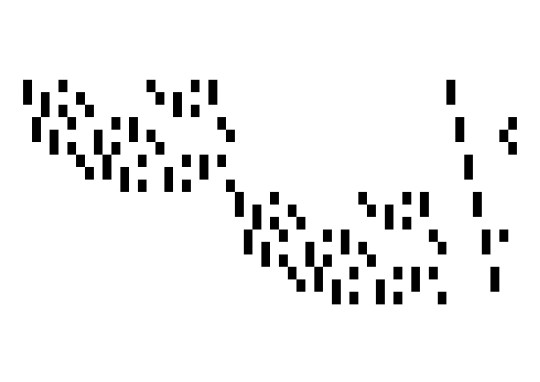
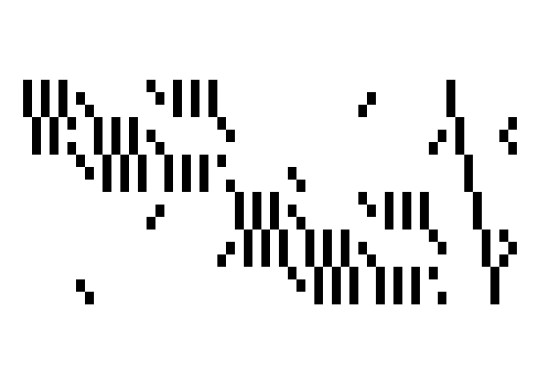

Four by nicky [nick-e] melville
L-R top (click to enlarge) 'Disconnect Level 1', 'Disconnect Level 2'
L-R bottom (click to enlarge) 'Disconnect Level 3' Disconnect Level 4'
Note from the author: In November 2022 I received an email from my letting agent with the subject heading ‘Preparing for Power Cuts or Planned Black Outs.’ News to me! (And to the staff of the letting agency I found out later.) The tone of the email presented this as an actuality rather than a possibility. The email then proceeded to give advice on what to do both before and after the looming black outs. Following this, I found HM Government’s contingency planning for an energy emergency, titled ‘Electricity Supply Emergency Code,’ which showed planning for national grid shutdowns over eighteen stages to complete blackout—societal breakdown in other words. The ‘Code’ dates from 2019, well before the current energy crisis so-called. ‘Power Cuts’ is a series of abstract representations of the planned pattern of national shutdown contained in the government’s plans.
Bio:
nicky [nick-e] melville is a poet, creative writing teacher, curator, editor, musician and occasional artist, whose work takes aim at and interrogates the imperatives of capitalism, politics and ideology. He has been grafting on and in the margins for over twenty years developing a range of publications in a variety of forms and genres: found poetry and erasures, visual poetry, lyric experiment, conceptual and post-conceptual writing. A Selected poems, Decade of Cu ts, was published by Blue Diode in 2021 and his 400-page anti-poem-novel hybrid, THE IMPERATIVE COMMANDS, his PhD project, has just been published with Dostoyevsky Wannabe. Earlier books include selections and dissections (Otoliths Press, 2010), a collection of visual poetry, and his ABBODIES series (Sad Press) which explore the neoliberal and fascist elements of Brexit through the lens of ABBA songs, aliens and James Bond. He makes music as Fuck This: https://fuckthis1.bandcamp.com
1 note
·
View note
Text
Mid-August Update
Hey y'all!
Nice to see you again. Remember how in my last post I said I was working on a reading/writing vlog? Yeah well, my camera decided to fill up with memory and I can't afford a new one.
Anyways, I am starting my sophomore year of college this week and I plan for my reading to slow down quite a bit (P.S. I started a studygram, let me know if that is something you would be interested in seeing here).
Other than all of that, I figured I would give you all an update for this month and what I have been reading, and how I felt about the books I decided to shove my nose into this month. I have to admit I was hoping I would have been able to read more this month, it is so hard to believe that this month is already halfway over. So far, I have read 3 books and am currently reading the 4th book. This brings my Goodreads total of books read to 27 (as of writing this 2 books ahead of schedule).
Every Vow You Break by Peter Swanson
I picked this up randomly and I went in with absolutely no expectations. I have never heard of this author (despite them being fairly prolific in the thriller genre) and I have to say this was NOT a good first impression. This book had both awful writing and terrible storytelling. The plot was absolutely all over the place and all of the characters were absolutely awful. The main character was just...so flat. Not to mention this thriller was not thrilling, if anything I kept reading to see how I'd want to slap the characters next. I don't this book had any redeemable qualities. Initially, I gave this a 2 star review but after comparing to it another book I gave a 2 star I bumped it down to 1 star.
City of Ashes by Cassandra Clare *this review contains spoilers*
I tried to read this book late last year sometime and the incest REALLY got to me. I expressed this to my friend and she told me that later Jace and Clary end up not being siblings (which helps me) but the fact that they really had a moment where they both basically said "I don't care if we're siblings" made me want to vomit. Their "romance" is set up to seem like they are star-crossed lovers and it is disgusting. Apparently, Cassandra Clare is kind of infamous for her incest "kink" so I'm not surprised looking back.
Beyond that, I really enjoyed this book and plan on continuing the series. I'm so mad that Ms. Incest Clare put my baby Simon through all of that, he really deserves better. I thought the writing was okay and I was entertained enough to keep reading fairly consistently. I gave this a 3 star out of 5 on Goodreads.
Furyborn by Claire Legrand
The final book for this update (and something that was actually on my August TBR, not that we are surprised). Let me start by saying that I have read this before but I did not remember absolutely ANYTHING about it. I don't know if it was because I read it almost 2 years ago or if God said "Nah, this isn't the right time for you to really appreciate this book" and just wiped my memory. Whatever happened to wipe my memory, I'm glad it did because o m g did I LOVE this book. If you go through my updates on Goodreads it's just being confused that I didn't remember this absolute work of art. I loved the double perspective and while Rielle's story was much more interesting (at least to me), I still loved Eliana and all of the characters (Including Corien even though he's toxic). I have already started Kingsbane (the second book) and Am already taking notes. I gave this book 5 out of 5 stars on Goodreads.
Like I said, I'm a little disappointed that I haven't read more this month but 2 out of these 3 books were 300-400 page fantasy novels so I'm cutting myself slack, especially since I am 2 books ahead of my goal (for now).
Good luck with the rest of your month and to those who are going back to school, I hope you have a good semester and study hard. I do expect my reading to slow down but I plan on continuing to update here. Starting from now a lot of my focus is going to be on my studygram but I won't abandon you all I promise.
Much Love,
June <3
#books#bookworm#reader#currentlyreading#booklover#bookblr#libraries#bookreviewer#currently reading#readers#books to read
1 note
·
View note
Text
‼️
#Just a PSA because I’m seeing a lot of people make posts about this after Harry mentioned it on that horrid interview!#In the original version of The Eyes of Darkness the novel actually didn’t even mention Wuhan-400.#Dean Koontz originally called the microorganism Gorki-400 a reference to a Russian city that#after the dissolution of the Soviet Union was renamed Nizhni Novgorod.#The Gorki-400 virus was created in the book by Russians with the intention of developing a biological weapon.#It was in 1988 after the end of the Cold War and with rumors going around at the time that China#had biological weapons the book was relaunched and needed a new villain so the name was changed#and also part of the characters who all got Chinese names.#Also the page that talks about 2020 is not even from the same book. That’s an excerpt from#“End of Days: Predictions and prophecies about the end of the world” by Sylvia Browne published in 2008.#I understand that conspiracy theories can be entertaining and all that but with all the racist assaults and ignorant attacks against#Asian people spreading faster than the actual virus it really is important for us to educate ourselves and#always fact check the information you see being spread on the internet.#There is nothing to indicate that the coronavirus is a “biological weapon” like the one depicted in the book.#It is simply a group of viruses that cause illnesses ranging from the common cold to more serious diseases.#Also Wuhan-400 has little in common with Covid-19. 1) There is no evidence that Covid-19 was created in a lab#or engineered by people like Wuhan-400 was. 2) According to the book Wuhan-400 “afflicts only human beings” and#“no other living creature can carry it”. Covid-19 is believed to have crossed over to humans from animals.#3) Wuhan-400 has a “kill-rate” of 100% while Covid-19 has a fatality rate of 2%.#So yeah both have an association with the city of Wuhan but the similarities pretty much end there.#This is in no way a callout to Harry or anything like that just thought it was important to debunk that because rumors and theories about#the virus have shown to be anything but harmless.
75 notes
·
View notes
Text
3 Tips For Making Writing More Fun
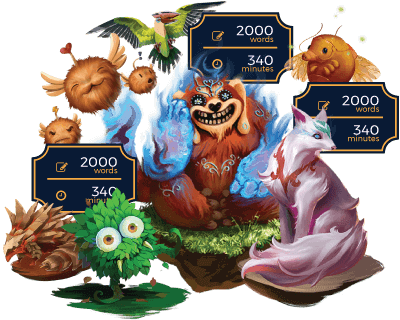
Every year, we’re lucky to have great sponsors for our nonprofit events. 4theWords, a 2021 Camp NaNoWriMo sponsor, is a writing app that uses monsters, quests, global challenges, and epic rewards to motivate your writing. Today, they’re here to share some ways that gamefying your writing can help you reach your goals:
Writing can be both rewarding and challenging. Most of the time, writing is an expression of creativity that makes us feel alive. At other times, getting words down feels like climbing a mountain. On those days, you might try almost anything to write. So we've come up with a few tips to help you make writing more fun.
At 4thewords we’re all about making writing more fun. Our online writing game helps you write more using gamification principles like monsters, leveling up, item rewards, quests, and a fully immersive world to explore. We want to make writing easy, fun, and rewarding for our community—all while helping you achieve your word count goals and get into a writing habit.
1. Break Down Your Goals
With writing, you might get overwhelmed by the big picture. How are you supposed to write an entire book? The same way you eat an elephant—one bite at a time. Instead of focusing on and fretting over the idea of writing an entire book, just focus on meeting a daily word count. By breaking your goals down into more manageable chunks, it'll be easier for you to achieve them. You can break your goal into incremental steps and use something like sticky notes to see how far you've come. If you set one sticky note to equal your daily word count, it won't be long before you cover your wall in a sea of sticky notes. At 4thewords we make it easy to track your writing progress and help motivate you with streaks, we have streak wings you can equip on your Avatar for keeping a writing streak (fun fact: our longest streak is over 5 years and running!)

2. Reward Your Progress
Along with breaking bigger goals into small parts, reward yourself whenever you reach those goals. As far as rewards go, think simple—even the promise of your favorite treat or purchasing a book you've had your eye on can work. Rewards are an important part of our strategy at 4thewords so if you want help finding some rewards dressing up your avatar and decorating your house with writing rewards might do the trick. By defeating monsters, you get rewarded with loot and can not only complete quests but also purchase special wardrobe items to accessorize your avatar. 4thewords offers limited-time special events with special rewards, so keep an eye out for those as well.
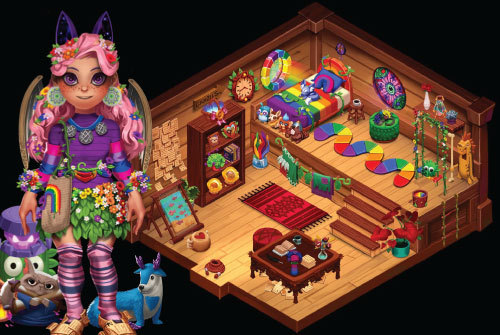
3. Get Creative
Don't be afraid to get creative with your writing goals! Instead of telling yourself, “I have to write 500 words today,” say, “I must defeat the Poison Dragon today!” Or “I must write 500 words to save my city!” Writing in 4thewords gives you the opportunity to personify your goals and visualize them as monsters for you to slay. We turn the creative process into an adventure that keeps you focused and engaged. If you're struggling with a challenging scene, figure out how many words you need to write that scene, equate them to a monster, and fight (we have over 400 unique monsters and our world grows larger every month)!
No matter how you choose to make your writing fun, 4thewords is here to help you reach your writing goals. Give us a shot with a 30-day free trial and discover the most entertaining way to make daily writing a habit and finish writing your novel.
Best of luck slaying your poison dragons and best of luck this Camp with your words, Wrimos—we hope you have a fantastic camp!
PS: If you use the special code “wrimocamp” when signing up or on your Account Page, you’ll get an extra free month of subscription time!
134 notes
·
View notes
Text
🌻 Book Tag 🌻
@arywizm threw out invitations to this party, so I stole an invitation in order to pretend I was invited to it. I am late to the party, as I am to all parties— late and uninvited, but I’ll pretend I’m the fashionable type of late, not the oblivious type of late.
1. How many books are too many books in a series?
I prefer to read duologies and trilogies (since I can only commit to two to three books at a time), but I’ll read multiple duologies/trilogies set in the same world. For example, the Shadow and Bone trilogy, Six of Crows duology, and King of Scars duology by Leigh Bardugo or The Raven Cycle and The Dreamer trilogy by Maggie Stiefvater (though technically The Raven Cycle is four books, not two to three books).
2. How do you feel about cliffhangers?
I prefer books that finish with enough closure that I don’t need to read the sequel, but with enough of a cliffhanger that I want to read the sequel. (Again, I am allergic to commitment.)
3. Hardback or Paperback?
I don’t prefer one or the other, but I do prefer physical copies to electronic copies.
4. Least favorite book?
Into the Wild by Jon Krakauer.
5. Love triangles, yes or no?
An enthusiastic, emphatic no.
6. The most recent book you just couldn’t finish?
Majesty, the sequel to American Royals, by Katharine McGee. Both American Royals and Majesty were physically painful to read. There is no justification for American Royals to be a book, let alone a 464 page book, let alone a 464 page book with a 384 page sequel.
7. A book you’re currently reading?
I’m currently reading The Foxhole Court, the first book of the All for the Game trilogy, by Nora Sakavic. I don’t typically read sports fiction/romance, but it was compared to Six of Crows and The Raven Cycle (both of which I fell in love with), so I had to read it.
8. Last book you recommended to someone?
The Extraordinaries by T.J. Klune. I adored The Extraordinaries. I had read (and also adored) The House in the Cerulean Sea, but it was The Extraordinaries that cemented T.J. Klune as a auto-read author of mine. I can’t wait to read the third and final book in the Extraordinaries trilogy (and I can’t wait to read Under the Whispering Door).
9. Oldest book you’ve read?
I have no idea.
10. Newest book you’ve read?
Any Way the Wind Blows, the third and final book in the Simon Snow trilogy, by Rainbow Rowell and Flash Fire, the second book in the Extraordinaries trilogy, by T.J. Klune.
11. Favorite author?
I don’t have favorite authors/books; I have all-consuming obsessions/fixations.
12. Buying books or borrowing books?
I only buy books if I’ve already read them and loved them (or if I’ve read other books by the author and loved them). Otherwise, I borrow books.
13. A book you dislike that everyone else seems to love?
Percy Jackson and the Olympians by Rick Riordan. I only read The Lightening Thief, but I didn’t like it enough to finish the series. However, I did read The Heroes of Olympus and the Kane Chronicles, and liked them enough to finish both series.
14. Bookmarks or dog-ears?
Bookmarks. I am too cowardly to dog-ear or otherwise fold the pages of a book.
15. A book you can always reread?
Fangirl by Rainbow Rowell and Carry On by Rainbow Rowell, both of which I’ve read countless times.
16. Can you read while listening to music?
No, I am incapable of reading with any noise, whether it's music, television, or otherwise.
17. One POV or multiples POVs?
I prefer multiple POVs (if it’s well written), but I won’t read a book for the multiple POV (or not read a book because of the single POV).
18. Do you read a book in one sitting or over multiple days?
Both. If it’s a shorter book (up to 400 pages), I’ll read it in a single sitting. If it’s a longer book (over 400 pages), I’ll read it over multiple sittings. I tend to read books in a single sitting over the summer, but read books in multiple sittings the rest of the year.
19. Who do you tag?
I’ll pass on an invitation to whoever else is fashionably late to this party.
#tag game with your friendly neighborhood bibliophile#tag game#booklr#bookblr#bookish#book#books#bibliophile#your neighborhood bibliophile#your friendly neighborhood bibliophile#Shadow and Bone#Six of Crows#King of Scars#The Raven Boys#The Raven Cycle#Call Down the Hawk#The Dreamer trilogy#The Foxhole Court#All for the Game#The Extraordinaries#Flash Fire#Carry On#Any Way the Wind Blows#Simon Snow trilogy
31 notes
·
View notes
Text

Happy New Year, everybody! I know that Literally no one cares or will read this, but I have to rate and talk about what I’ve read this year and this is my page, so deal with it.
2020 may have been a dumpster fire of a year, but I did read so me pretty good books. I didn’t get to read as many books as I wanted (like always), but that’s life. If you couldn’t tell, I do have a preference for romance novels, and these selections are very... 🌈 and I wouldn’t have it any other way.
Here we go:
- Lies we Tell Ourselves by Robin Talley (4/10)
- I think I could write a dissertation about why I have a problem with this book, but I think I can just stop with “a white lady writing an interracial queer romance in the 1960s where the lead white character is literally a racist” should about cover it. Absolutely disappointed.
- Red, White, and Royal Blue by Casey McQuiston (10/10)
- Oh my god does Casey McQuiston know how to write a book. Classic enemies to lovers, my favorite trope. This is my comfort novel that I use as a form of escapism, and probably the reason I didn’t read many new books, as I reread it about five times. It’s my comfort novel, and I come back to it every time I need to feel happy. I’ve made three of my friends read this book, and I recommend it to everyone
- These Witches Don’t Burn by Isabel Sterling (8/10)
- It’s sapphic, it has witches, and it’s adorable; what more could you possibly want? The ending left me wanting more. I was finally able to buy the sequel and I can’t wait to get into it.
- Boy Meets Boy by David Levithan (7/10)
- I think this book is sort of a classic when it comes to gay YA. This was a pretty good book, but it took me awhile to get into it.
- Her Royal Highness by Rachel Hawkins (9/10)
- What did I say about enemies to lovers? HRH was regarded as sapphic Red, White, and Royal Blue, which I think is all you need to know to be interested. This book and short, sweet, and to the point. It’s an easy read (I read it twice, both times in one day). I think there could’ve been some more character building, but it’s so adorable I literally do not care. When I say I want more cute gay romcoms, they should use HRH as the blueprint.
- It’s Not Like It’s a Secret by Misa Sugiura (7/10)
- A cute, interracial sapphic love story where no white people are involved (the main character is Japanese American and her love interest is Mexican American). This coming of age story deals with acceptance, cultural differences, racism, and coming out. I think some of the points it was trying to delve into were too much on the nose at some times, but I really enjoyed this book.
- The Gentleman’s Guide to Vice and Virtue and The Lady’s Guide to Petticoats and Piracy by Mackenzi Lee (9/10)
- A fun romp set some time in the 1700s with a chaotic bi as the main lead? Count me in! I read this whole series this year, including the novella (the gentleman’s guide to getting lucky), and I loved every second of it. It’s an adventure series with some romance sprinkled in (a hella slow burn, but definitely worth it). The whole series has gay, bi, lesbian, and ace aro representation, and I was in love the entire time.
- You Should See Me in a Crown by Leah Johnson (8/10)
- The black sapphic book I needed. Liz Lighty decides she wants to leave her hometown and go to college, but after losing the financial aid she was counting on, she remembers the scholarship that prom queen gets every year, and decides to run. Sprinkle in a cute love story, and I’m hooked.
- The Song of Achilles by Madeline Miller (10/10)
- I... cannot put into words how this book made me feel. When I finished TSOA, I cried all night trying to recover. Beautifully written, and I still can’t get over Achilles and Patroclus. One of my favorite books this year.
- Sorry Not Sorry by Naya Rivera
- After Naya’s tragic passing in July, I struggled to find her autobiography anywhere. However, I was finally able to get my hands on it, and am so glad that I did. Naya Rivera was just as genuinely funny and carefree as her previous costars have said, and I wish the world could’ve gotten more of her.
Not pictured:
- Of Fire and Stars by Audrey Coulthurst (9/10)
- Sapphic love story about a princess who has been betrothed to a prince from a nearby country her whole life who instead falls in love with his sister. The main character, Denna, also possesses magical powers, which is forbidden in their land. One of my favorite things about this book is that it’s set in medieval times, but no one cares about queer relationships. The only problem with Denna falling in love with the princess is that she’s betrothed to her brother and nothing else. I recently bought the sequel to this book as well, and I’m excited to read it
- The After Series (books 1-2) by Anna Todd (-400/10)
- I was curious about this series because of how terrible the movies are, and needed to read them myself. I apologize to myself every day that I every even wasted my time on these two books. If I ever see Anna Todd, it’s on sight immediately. Not only is the writing terrible, but the romanticization of abusive relationships is absolutely unacceptable. I think I could take less issue with these books if the author wrote them as a “what to look for in men you should never date” rule book, but it isn’t. I could actually write an essay on why these books are more harmful than entertaining and how I genuinely think this series should have never been published. Also, Harry Styles did not deserve this.
I also discovered WEBTOON this year, and here are some of my favorites that I have read:
- Always Human by creator walkingnorth, a finished WLW story which was absolutely beautiful to look at and delightful to read.
- Lore Olympus by creator Rachel Smythe. I don’t think you can find too many people who haven’t heard of this story, but it’s a retelling of the Hades and Persephone mythology, and I adore it.
- Novae by creators KaixJu. A historical, queer and paranormal romance about a necromancer who falls for an astronomer.
- My Lady Artemisia by creator rimarza. This WEBTOON is a little bit newer with fewer episodes, about a knight tasked with guarding the princess, which starts to prove difficult once she starts to gain feelings for the princess, and an impending threat might cause her to past to come to the surface.
Of course, I’ve also spent a lot of my time on A03. I know I’ve read more, but here are the ones I bookmarked and have come back to this year:
- kiss me (if you mean it) by nerdybutpunk
- Carry On fanfic, short but sweet, absolute fluff
- Camp Llwynywermod by bleedingballroomfloor
- Red, White, and Royal Blue AUwhere Henry and Alex are camp counselors. It’s so good and I find myself waiting every wed and sat for the updates.
I read more this year than I have in a long time, and I enjoyed it most of the time. My goal for 2021 is to read at least two books a month and to expand my horizons to something that isn’t YA and isn’t romance. Also to find Anna Todd and tell her off. Hopefully we can accomplish some of that.
#rwrb#lgbtq lit#lgtbqia+#carry on#alex claremont diaz#henry montague#ggtvav#after series#naya rivera#wlw#her royal highness#tsoa#achilles#patroclus#patrochilles#you should see me in a crown#these witches don't burn#these witches gay#of fire and stars#henry fox mountchristen windsor#lies we tell ourselves#robin talley#booklr#lgbtq books
192 notes
·
View notes
Note
hi, any advice on timeline and era etc stuff? I have dyscalculia so numbers and measurements are meaningless to me and it’s really difficult to figure out how much time should lapse (on a large scale; time periods, millennia, eras, etc, not stuff like in one persons lifespan) between eras and events, especially in regards to political n social n technological etc changes
Feral: That depends. There isn’t one answer. You’re asking for longer time periods than a generation or a lifetime, but for scale, take what’s happening now. How many calamities, major political events, social trends, and changes in technology (and how we interact with it) have happened in the year 2020? Since the year 2016? Since 2008? Since 2001? How are they grouped together or spaced apart? And these are all working on each other. In the USA where I live, the 9/11 attacks absolutely have a direct causal effect with the politics that led to the 2016 election (actually before that a Supreme Court decision in the 2000 election also had an impact on that result), and the results of the 2016 election impacted how COVID has been handled this year. That’s 20 years, so when we’re looking at longer timeframes, we scale up. We see gaps and groupings and there just isn’t a specific “oh every decade/score/century, these types of events happen.”
To quote a particularly relevant introduction on Wikipedia:
This results in descriptive abstractions that provide convenient terms for periods of time with relatively stable characteristics. However, determining the precise beginning and ending to any ‘period’ is often arbitrary, since it has changed over time over the course of history.
To the extent that history is continuous and not generalized, all systems of periodization are more or less arbitrary. Yet without named periods, however clumsy or imprecise, past time would be nothing more than scattered events without a framework to help us understand them.
Eras, of the non-geological or -cosmological sort, or time periods are culturally determined, completely variable in length, and often overlap. For example, the beginning of the Victorian Era, 64 years, (defined by Victoria’s rule of England) of the Anglo-influenced world overlapped with the Antebellum Era, 78 years, (defined by political and social tensions in the lead up to the American Civil War) of the United States, which is also part of the Anglo-influenced world, and then following the end of the Antebellum Era, was the American Civil War, 4 years, and then the Reconstruction Era, 14 years (the first 2 of which are within the Civil War), which are both fully contained within the Victorian Era. Typically, when you are trying to think about eras, think about political rulership, wars, and large scale trends like artistic styles. It may also be helpful to familiarize yourself with the Three-Age System, which can be applied individually on cultures, rather describing trends for the whole world.
What it really comes down to when we think of eras and time periods is almost like a type of pareidolia. People see groupings of like things happening and put this grouping into a bubble of time, which kinda doesn’t actually exist in objective reality and is more or less a group hallucination on a massive scale. It calls to mind what Zeno’s arrow might have actually been trying to describe - not to say that this paradox is infallible, but it’s an interesting thought exercise, especially once you get into the quantum Zeno effect.
Now that I have fully diverged from the question at hand, we’ll get back to it. Let’s look at one technology type and how much time elapses between developments as well as some tie-in technological, social, and political forces that may be acting on the developments or that the developments might be acting on. I’ll also note how this technology traverses the eras of history as I find that looking at one discrete set over time is easier than just trying to look at the big picture. Let’s look at the history of printing.
(With hopes that it will be easier for you to conceptualize, I will use simplified (aka rounded up/down) timeframes written numerically rather than spelled out or via terms like decade or century so at the very least you can compare length of numbers. I’m also going to link as many Wikipedia articles as I can - I like Wikipedia for this because of its incredible cross-indexing and how it strings relevant articles together into a series, often chronologically. If the numbers are still challenging for you, I will summarize without at the end.)
5,520 years ago, the very first form of printing we know about is done with cylinders rolled over wet clay in Sumer in 3500 BCE, the beginning of the Early Bronze Age.
3,700 years later, woodblock printing is developed in China somewhere around 200 CE/AD, just after the end of the Pax Romana in Europe.
700 years later, the next development of printing is movable type, which is developed in China in 1040. 26 years later, on the other side of the world, in 1066 is the Battle of Hastings and the establishment of the Norman Era of rulership in England, in another 20 years, in 1086, the Domesday Book is hand written in 2 volumes: 1 is 764 8”x15” pages, the other 900 8”x11” pages.
400 years later gives us the Gutenburg printing press that is developed in Germany (at the time in the Holy Roman Empire) in 1440. This is during the Renaissance Era; it’s also the Era of Humanism, and often called the Early Modern Period. Martin Luther will write the 95 Theses less than 80 years later and start the Protestant Reformation, largely thanks to the ability for the theses to be easily copied by the printing press and spread quickly.
75 years later we have etching in 1515. 90 years later, the first weekly “true” newspaper, the Relation, begins printing in 1604.
130 years later we have mezzotint in 1642, which is the start of the First English Civil War, which will last for 4 years. Depending on your preference, the Age of Enlightenment either began 5 years before or 40 years later (unless you’re French).
130 years later we have aquatint in 1772. That is right at the beginning of the American Revolution: 2 years after the Boston Massacre; 1 year before the Boston Tea Party; 2 years before the Intolerable Acts and the First Continental Congress; 3 years before Patrick Henry’s “Give Me Liberty or Give Me Death” Speech (which is printed and shared across the colonies), Paul Revere’s Ride, and the Battle of Lexington & Concord; and finally 4 years before Thomas Paine’s Common Sense is published, the signing of the Declaration of Independence (which is printed and shared across the colonies), Nathan Hale’s execution for treason against the Crown, and Washington’s Crossing of the Delaware.
25 years later lithography is developed in 1796; the year prior Napoleon overthrows le Directoire.
40 years later we have chromolithography in 1837, the year Victoria ascends and the first electric/battery powered locomotive is invented.
5 years later is the rotary press in 1843. The First Industrial Revolution is over.
15 years later is the hectograph in 1860. 1 year later, the American Civil War begins.
15 years later is offset printing in 1875. 1 year before, the first commercial typewriter becomes available. 1 year later is Bell and Watson’s first phone call in 1876.
10 years later is hotmetal typing in 1884.
1 year later is the mimeograph in 1885. 2 years later is Black Monday. 5-10 years later the radio is invented.
20 years later is the photostat and rectigraph in 1907.
4 years later is screen printing in 1911. 3 years later WWI begins in 1914.
10 years later is the spirit duplicator in 1923. The Roaring Twenties.
2 years later is dot matrix printing in 1925. 4 years later is the Great Crash.
10 years later is xerography in 1938, the same year as the first digital computer. 1 year later WWII begins in 1939.
2 years later is spark printing in 1940. 1 year later is the Attack on Pearl Harbor.
9 years later is phototypesetting in 1949. The USSR detonates their first atomic bomb.
1 year later is inkjet printing in 1950. Truman orders the development of the hydrogen bomb. Apartheid becomes law in South Africa.
7 years later is dye-sublimation in 1957. 6 years later, Martin Luther King, Jr. gives his “I Have a Dream” Speech.
12 years later is laser printing in 1969, the summer of which is known for very Very.
3 years later is thermal printing in 1972. The break-in at the Watergate Office Building is this same year and 2 years later Nixon resigns.
14 years later is 3D printing in 1986, the year Pixar Animation is founded and the year after the beginning of the Iran-Contra Affair.
1 year later is solid ink printing in 1987. 2 years later is the invention of the World Wide Web, and the internet as we know it.
4 years later is digital printing in 1991, the same year the USSR dissolved. 2 years before, the Berlin Wall fell.
There have been no significant developments in the history of printing since 1991.
So, let’s look at some averages to help us consume this data. Printing has a history of 5,520 years. It took 3,700 years for another development to occur, and then another 700 years after that - in other words, in the first 4,400 years of printing, there were 3 developments, equalling to an average of 1 every 1,470 years. In the 400 years between 1440 and 1843, there were 7 developments (average of 1 every 57 years). In the next 100 years between 1860 and 1957, there were 14 developments (average of 1 every 7 years but with 1 year having 2 developments simultaneously). In the next 22 years between 1969 and 1991, there were 5 developments (average of 1 every 4 years).
While the general trend is that the more a technology develops, the faster it develops, a trend is not the whole picture. Consider: in the 90 years of 1796-1885, there were 6 developments, making the average 1 every 15 years. In the 85 years of 1907-1991, there were 15 developments, making the average 1 every 6 years. There has not been a development in the past 30 years! There hasn’t been this large of a gap since 1837, 180 years ago.
In general, without numbers, what I think we can see here is that sometimes a certain development, like the printing press, can usher in a new era, and sometimes reactions to what else is happening in the world can pressure someone into developing something new, but often times, most times, when you look at just one thing under microscope over time, why that thing is produced in this era but not that era has nothing to do with the eras in question. When we create time periods, we’re generally doing it after the fact. No one living under the rule of the Roman Empire in 100 CE was thinking to themselves, “ah yes, the Pax Romana, when we have peace for 200 years!”
So applying all of this to worldbuilding, I see two methods that you can use together, to create a timeline that makes sense and is useful to your storytelling.
Method the first, arbitrarily create time bubbles of various lengths - I recommend the use of index cards for this. Index card A is 7 years; card B is 150 years; card C is 47 years and so on. Then take big ideas and put those onto your cards; use inspiration from real history. “I want the War of the Roses but condensed into 7 years.” “A Mongolian Empire type expansion happens over 150 years.” “There’s a 47 year Renaissance of fascination with Ancient History.” Then take those cards, lay them out into roughly the order in which you want them to occur, maybe overlap them a little, especially if they are happening in different parts of your world. Remember that time is not actually linear and things do not happen in a linear, narrative manner in the real world, so there can be wild leaps; there can be regressions; and you don’t have to follow real world history here - though you may want to the first time as a helpful exercise. It’s also very unlikely that you will ever have to know exactly how many years are between the eras or what the interstitial eras are.
Method the second, list all the major historical events, inventions, etc that you want/need to have happened. Start with what directly impacts your main characters and plot. “MC’s great-grandfather is humiliatingly defeated in battle, casting a pall of embarrassment across the generations following and ultimately putting the MC in the position that she starts in.” “The first great wizard codifies the 10 Laws of the Important Magical Order that the MC is trying to earn her place in.” Put these in an order that makes sense to you, keeping in mind that it’s not going to be a perfect progression. Again, you don’t need to know how many years there are between each event, but if great-grandpa was the last in a very long line of family members allowed to be in the Important Magical Order, then that IMO had to be founded first, and there would probably be some events between these two.
Then, when you have your two timelines, one of era/time periods and one of events, graft them together. You may have to shift some things to make it work, but consider the “feeling” or theme of the eras and what events make sense in relation to those feelings. Additionally would this event be more suited to happening when the era is new and is finding itself or when the era is solidly on course or is it an event that would completely shatter the illusion of the era and usher in a new one? Does it make sense for your great wizard to be codifying her laws in the expansion of an empire, or during a period of relative peace and prosperity in an established empire, or before empires were a thing in this world and few traveled far from home?
Tex: I’ve found that historically important events are caused for roughly two reasons - one, an invention that others capitalize on for an exponential growth into other inventions/social uses, and two, someone got sick of someone else’s crap and did something about it. Natural disasters will happen with enough frequency to be noted (see: the Little Ice Age, the Black Death, and the 1883 eruption of Krakatoa), although there’s little prediction for them because of the lack of observable build up in activity.
To pull from Feral’s timeline of examples, writing is popularly attributed to being invented in Sumer, 5,520 years ago - it’s our oldest found example, at any rate, though I’ve learned to never say never on archaeological discoveries.
What prompted this invention? Things rarely occur out of the blue, and rarely without interaction from other domains - where could writing have come from? Maybe art? What about from the creation of a tool, a reuse of certain skill sets? Something else we haven’t thought of yet?
So that’s one half of the question. But what about the other half - what did people around the inventor (multiple inventors?) think of this new thing? Deliberately associating a particular sound with a particular object - even a 2D object like pressing shapes into a piece of clay - and then standardizing it, is no mean feat. How did this agreement even happen? Were there arguments about how to do these graphemes, how best to shape them? What about which phoneme to each?
I doubt Sumerian cuneiform was created in a day, and likewise I doubt that language popped into existence on a whim. To keep pulling from this example, language composition has a strong effect on how we interact with our environment (University of Missouri-St Louis Libraries), but it conversely is also deeply affected by the environment its users create (Nature).
Because of this, I think it’s easier to work from a different angle - figure out what your major events are, and what eras you’re covering. If these major events also define an era, that’s even better! Working out how long everything each thing takes is ultimately a bunch of minor details, so it’s up to you how much your plot actively needs them, rather than decoration to your story meant to amuse you more than your audience.
58 notes
·
View notes
Text
attended to his letters; a course of reducing exercises
or did you hear commentaries [ ] over the radio?
I don’t have the time to do it.
You don’t have time to do it. 1
and that, of course, you don’t have time to was taught the game 2
increasing the feed for / my dope, but you don’t have time 3
You don’t have time to investigate them fully yourself?
No 4
It was hard work? —
Yes, sir. You have to be fast and do the best you can. You don’t have time 5
for nearly everything; you don’t have time 6
You don’t have time to bother about your neighbors, and you don’t 7
enjoy our own com . pany , as we never have any chance to see friends around home, for you don’t have time after and before 8
And in some cases wastefully? —
Not wastefully.
Does not one involve the other? —
I don’t see it in that light. A man applies for relief. You don’t have time to see that man. 9
you don’t have time to spend one hour in thinking every day to see your business in a bigger, better, and cleaner way than it is today.
[ ] desk covered with papers, unfinished business, no time to see 10
the “ticket” for large swamps. You don’t have time 11
You see, when you’re on the news end of a thing like this you don’t have time to get worked up. 12
“Well,” she said, “I suppose you are so busy at the office you don’t have time. 13
you are so terribly busy that I suppose you don’t have time to feel lonesome.
Why can’t girls do something like that, too? 14
“How did you like it down there?” he asked.
“Well” — she paused thoughtfully — “down there you can keep busy.
There’s something to do all the time; you can keep so occupied that you don’t have time to stop and think and feel.” 15
you don’t have time to think of danger”
But one foggy morning not long after... 16
today. always say you don’t have time to read. ward, like a girl 17
By the time he had days.
When you’re busy you don’t have time to
attended to his letters. 18
a course of reducing exercises, you don’t have time to think of that.
I don’t believe I’m abnormal, perhaps I am, but 19
Well, I use two formulas;
saying you “don’t have time” is part of the world of citation.
Saying you “have time” is part of the world of translation.
I think that the questioning typical of translation has always been absent in the plastic arts. 20
sources ( “you don’t have time,” all but two pre-1923 )
1
ex reporters’ transcript, April 20, 1959, The People of the State of California, Plaintiff, vs. Louis Estrada Moya, et al., Defendent, being part of the Transcript of Record, Supreme Court of the United States, October Term, 1960, No. 186, Luis Estrada Moya, Petitioner, vs. California on write of certiori to the Supreme Court of the State of California (petition filed June 9, 1960; granted June 27, 1960) : 200
aside —
Google misdated this 1832; 1960 was outside of my search range. A well-known case (I was too young at the time to know it). Some sources :
◾ “A mother-in-law’s murder for hire scheme results in death penalty for all three participants” at vcdistrictattorney, in which this : “What made the case unique? The hired killers testified against Mrs. Duncan without commitment [that] the District Attorney would not seek the death penalty in exchange for their testimony... In fact, all three received the death penalty and were executed. Of course, today’s appellate courts would likely reverse a case in which a defense attorney failed to seek sentencing concessions in exchange for testimony.” ◾ Arlene Martinez, “Love, scandal and murder: Ventura County case drew national attention,” VC Star (June 29, 2013) ◾ Alice de Sturler review of Jim Barrett his definitive Ma Duncan at Defrosting Cold Cases (October 17, 2020) ◾ Cecelia Rasmussen, “A Mother’s Love Was the Death of Her Daughter-in-Law,” Los Angeles Times (January 20, 2002; paywall) ◾ Joan Renner, “Dead Woman Walking: Elizabeth Ann ‘Ma’ Duncan,” parts 1-4 (2013) at Deranged LA Crimes (True 20th Century tales of murder, mayhem, political corruption, and celebrity scandal) and, finally, ◾ wikipedia
2
OCR cross-column misread, at Annie Eliot, “John Emerson Gaines’s Love Affairs,” The Manhattan 2:5 (November 1883) : 467-475 (468)
snippet view only, opens to hathitrust.
Annie Eliot Trumbull (1857–1949), author of novels, short stories, and plays; associated with Hartford, Connecticut’s “Golden Age”. wikipedia
3
OCR cross-column misread at H. E. Browing on “Pig Tails,” at The Swine World (Google titles it Poland China World) 5:2 (September 1917) : 11
4
ex Statement of William E. Johnson, chief special officer, United States Indian Affairs, before Committee on Indian Affairs, re: Senate Resolution No. 263 (Washington, 1910) : 367-400 (392)
an intense exchange, on sale of alcohol on reservations. William E. “Pussyfoot” Johnson (1862-1945) was an energetic and resourceful prohibitionist and law enforcement officer. (wikipedia)
5
here, Julius Baum, examined by J. R. Lamar (January 29, 1896), in Contested Election Case of Thomas E. Watson Vs. J.C.C. Black, from the Tenth Congressional District of the State of Georgia, and published in/by the U.S. Congress, Committee on Elections (Washington, 1896) : 535
aside —
an episode in the dismantling of Reconstruction institutions and Black suffrage. ◾ Thomas E(dward). Watson (1856-1922) (wikipedia). ◾ Watson is discussed in Jo Ann Whatley, her remarkable MA thesis Pike County Blacks : the spirit of populist revolt and White tolerance (1891-1896) as depicted in the Pike County Journal and other related sources (Atlanta University, 1984), available here ◾ Watson was succeeded by James C(onquest). C(ross). Black (1842-1928) (wikipedia).
“Black was declared the winner of the election but Watson charged that the vote was fraudulent. Black agreed to resign his seat just after the opening of the 54th Congress so that a new election could be held. In the October 1895 special election, Black prevailed over Watson again, and thus took his seat back to fill the vacancy caused by his own resignation.”
J.C. C. Black entry, at Biographical Directory of the United States Congress
6
ex Investigation of Hazing at U. S. Military Academy, being “Testimony taken by the Select Committee of the House of Representatives appointed to investigate and report on the alleged hazing and resulting death of Oscar L. Booz, late a cadet at the Military Academy, and upon the subject of the practice of hazing at the said academy.” (1901) : 776
7
another contested election, here Mrs. Louise Roller under cross-examination by Mr. Goldsmith, in Scholl, Charles L. Vs. Bell, Henry A. Jefferson Circuit Court (Louisville, Kentucky), Chancery Branch: First Division, Chas. L. Scholl, Plaintiff Vs. Henry A. Bell, Defendant. No. 41519. / Second Division, Arthur Peter, Plaintiff Vs. Chas. A. Wilson, Defendant, No. 41524. : “Contested election cases heard together,” Transcript of Record, Volume 8 (10 volumes in 9) : 39 (snippet only, but in full at hathitrust)
8
ex report from Washington Division (by Cert. 9730), 23:5 (May 1906) [number/month uncertain, could be June] : 712 (opens to hathitrust; found via google snippet view)
9
ex the “Poplar Inquiry,” here an examination of Mr. P. G. Miles, Relieving Officer, in Transcript of Shorthand Notes taken at the Public Inquiry held by J. S. Davy, C.B., Chief General Inspector of the Local Government Board, “into the general conditions of the Poplar Union, its pauperism, and the admnistration of the guardians and their officers.” Presented to both Houses of Parliament... (London, 1906) : 141
On the Poplar workhouse, see workhouses.org.uk (scroll down (near bottom) to “The Poplar Union Scandal and Inquiry”). ◾ Poplar is a district in East London (wikipedia)
10
ex E. Elmo Martin (Cleveland, Ohio), “How to hand the day’s work,” in National Lime Association Proceedings (Twentieth Annual Convention, Cleveland, Ohio; June 13-16, 1922) : 68-76 (73) (snippet view; full view at hathitrust)
11
ex H. Stimmons (Stark Co., Ohio), “More about coon hounds,” Hunter-trader-trapper 25:3 (December 1912) : 87-89 (88) (snippet view at Google, but full view at hathitrust, NW second paragraph)
12
ex Wayland Wells Williams (“author and artist,” 1888-1945), The Whirligig of Time (Frederick A. Stokes, 1916) : 335
Wayland Wells Williams papers at Yale YCAL MSS 551
13
ex T.I.M., “Dimpleton Stays at Home : A Story with a Real Moral,” in Life (July 25, 1907) : 155-158 (156)
14
snippet view only, at The Cactus (Austin, Texas; 1908) : 275
A journal “published by and for the students of the University of Texas”; 1907 and 1909 (but not 1908 alas) at hathitrust.
15
“down there” being Chicago,
ex Henry Oyen (1883-1921), chapter 36 of “Big Flat,” in The Country Gentleman 84: (March 8, 1919) : 20, 22, 57-59
The novel was published in 1919, same passage at p 204 (NYPL copy) ◾ Haven't located much information about Oyen; his published work is listed at his Online Books page
16
Homer Randall. Army Boys in the French Trenches Or, Hand to Hand Fighting with the Enemy (New York: George Sully & Company, 1918) : 199
Six “Army Boys” titles were produced by the Stratemeyer Syndicate 1918-1920, all under the pseudonym Homer Randall : Army Boys in France, Army Boys in the French Trenches, Army Boys on the Firing Line, Army Boys in the Big Drive, Army Boys Marching into Germany, and Army Boys on German Soil (stratemeyer.org) ◾ The Stratemeyer Syndicate records (1832-1984; bulk 1905-1984) are at NYPL ◾ See also Stratemeyer pseudonyms and series books : an annotated checklist of Stratemeyer and Stratemeyer Syndicate publications / compiled and edited by Deidre Johnson (1982); Deidre Johnson, Edward Stratemeyer and the Stratemeyer Syndicate (Twayne Publishers, 1993); and wikipedia
17
OCR cross-column misread at Harriet Winton Davis, “With the Children : Don’s Knitting,” in The Congregationalist and Advance (August 29, 1918) : 241
Other (not this) issues at hathitrust
18
OCR cross-column misread (extended here), ex H. D. Morgan, Ph. C., “The Kid,” in the section Original and Selected : From the best writers, and the leading drug, medical, chemical and scientific publications of the world, in Practical Druggist and Pharmaceutical Review of Reviews (November 1908) : 529-534
19
Frank R. Adams (1883-1963), “The Heart Pirate,” (illustrations by Charles D. Mitchell), in The Cosmopolitan 72:3 (March 1922) : 43-48, 117-118 (44) — snippet view, but opens at hathitrust
More —
“... yell for a diet and start doing a course of reducing exercises, you don’t have time to think of that. I don’t believe I’m abnormal, perhaps I am, but just since this afternoon I have come to the conclusion that if you want to put down crime you’ve got to suppress more than just alcohol — you’ve got to suppress the modern flapper. They’re so damnably desirable...”
(It gets worse...). See wikipedia; author’s papers at Oregon
20
ex Giuseppe Caccavale : in giardino, a buon fresco (content by Laura Cherubini, Giuseppe Caccavale, Chiara Bertola and Claudia Gian Ferrari; Charta, 2009) : 77

Needed another line, and thought Samuel Beckett might provide.
Search yielded no Beckett, but the above passage, fitting in its way and no more nor less ambiguous than anything else here.
something recent —
Giuseppe Caccavale « Projet Paul Celan », Residence Concordia, Parigi gennaio-ottobre 2020; testo e foto dell’artista. (1 February 2021)
method
A friend reminded me, recently, that I don’t have time (for what is irrelevant here).
Have been ruminating on (avoiding the consequences of) this, since. And thinking too about the place dimension of time, as discussed by Veronica O’Keane in her The Rag and Bone Shop : How we make memories and memories make us (2021) —
“One’s sense of time is inseparable from events, but this is a sense of time. Might time have something to do with place cells?” (107) and “The whole concept of time is generally unhelpful in understanding science, be it physics or neuroscience... From the perspective of recording events, the present is consciousness. In a seemingly ironic twist, I myself think that the only place that time does not exist is in the moment of consciousness...” (113)
The encountered lines — all included above from my search in pre-1923 sources — have found their respective though non-chronological places in a kind of rocking, panning motion, in which sediments settle into their respective ripples / couplets.
Would, could, does this — sequence — work (whatever “work” means) without the anchorings / tetherings / bibliographic wastefull(ness; line 9 above) that follow it? They were needed in the making, anyway, and for there to be sufficient distraction for the making to sustain.
all subject to change.
#contested elections#couplet#time#swamps#waste#Poplar Inquiry#Giuseppe Caccavale#William E. Pussyfoot Johnson
21 notes
·
View notes